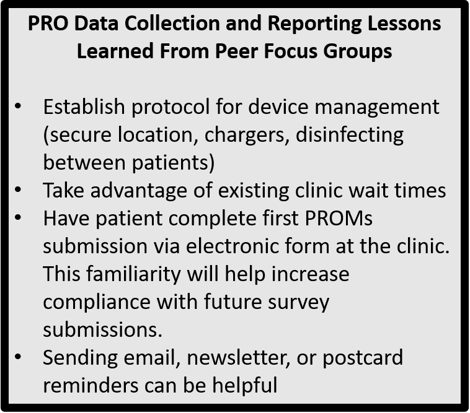
Patient-reported outcomes (PROs) provide insights beyond standard clinical quality-of-care measures and further guide physician and patient understanding concerning patient health status, the decision-making process regarding patient care, and the evaluation of effectiveness of quality improvement initiatives. Building your PRO program begins with setting program goals and creating a successful process for PRO data collection and reporting.
One of the biggest challenges within a developing PROs program is compliance with the data gathering process. The diagram at the link below represents the typical workflow supporting a hospital's electronic-based patient-reported outcome measures (PROMs) collection to action effort.
Research has shown that the five workflow features listed below demonstrate valuable efficiencies within this process, and help to ensure that clinicians and patients will find program data collection and reporting requirements manageable and worthwhile.
5 Workflow Features for Implementation:
#1 – Response automation refers to data entry through electronic options such as touch screen, stylus, or mouse.
#2 – Tailored item selection and reporting algorithms refer to consideration of specific needs for both clinical and administrative reporting. A clinical example would include factors like the type of recipients (physician, patient), type of reporting (alerts, in-visit reports), or the degree of score interpretation tailored to various participants. An administrative example might need to accommodate a patient's non-English, cognitive impairment, or visual impairment requirements.
#3 – Flexibility in collection location refers to consolidation of multiple data sources including at-home, in-clinic assessments, hardware used, and Internet connectivity available.
#4 – Integration with patient data elements include capacity for PROs to be stored in the patient's electronic health records (EHR) or a registry, adherence to patient privacy laws, user authentication, and granularity of PRO data reporting (item/raw score/standardized score).
#5 – An assessment completed in less than ten minutes helps ensure compliance with the reporting process.

*R. Jensen, PhD, N. Rothrock, PhD, E.M. DeWitt, MD, M.S.C.E., The Role of Technical Advances in the Adoption and Integration of Patient-Reported Outcomes in Clinical Care.
Next Week: Wednesday, January 24, 2018 - PRO Data Interpretation: 5 Analytic Resources and Tools to Consider
Be sure to leave a comment in the form below!


